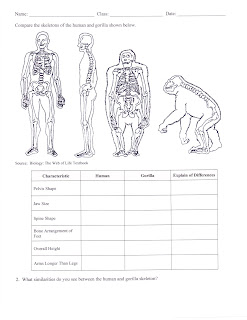ESSENTIAL QUESTION: What evidence supports the idea that life on earth can change?
RELEVANCE: Prove it to me!
NGSSS: SC.912.L.15.1; MAFS.912.N-Q.1.1; LAFS.910.SL.1.1
LEARNING OBJECTIVES: Students will be able to:
-Identify bodies of evidence that support the scientific theory of evolution.
-Recognize anatomical similarities such as homologous structures and vestigial organs when referring to comparative anatomy and comparative embryology.
BELL RINGER - Human Evolution - Comparing Primates-Comparative Anatomy part One/Part Two
VOCABULARY: biogeography, brain stem, cerebellum, cerebrum, comparative anatomy
HOME LEARNING: notebook update
AGENDA
WHOLE GROUP
We reviewed interdisciplinary connections and related them to current ELA benchmarks and other topics.
The bell ringer was to complete the comparing primates comparative anatomy part one section of the handouts. All handouts will be listed below.
We then collected and reviewed the home learning.
We related various methods by which scientists can confirm the theory of evolution, using the remainder of the packet. We did not complete our studies and will do so next class session.
All handouts can be found below.
Use this page as your bell ringer. Measure the thumbs from the to of the thumb (left appendage) to the base of the wrist for consistency.
SMALL GROUP/INDEPENDENT PRACTICE/DI
Students who complete work early should to to Edgenuity and work on the topics they received less than 70% from the last exam
HOTS:
-Which method of evidence for evolution is the strongest? Why do you think so?
-How might the fossil record mislead someone in trying to create evolutionary ties between two species/organisms?
EXIT STRATEGY:
Molecular Biology Summary Question.










